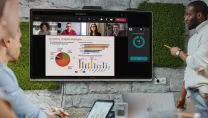While Europe is starting to consider a return to the office, hybrid working is more popular than ever. Ian Barnard, Senior Vice President Marketing & Product Management, Sharp NEC Display Solutions, looks at how businesses can better integrate hybrid meetings to keep employees connected and engaged.
The rise of hybrid working has led to a significant shift in the way we work. Hybrid meetings are becoming increasingly prevalent, with participants joining from both the office and virtually. There are plenty of challenges that businesses adopting such hybrid solutions need to overcome if they’re going to be successful, however.
A recent report from Sharp surveyed over 6,000 office workers in SMEs across Europe suggested that workers are struggling to get to grips with video conferencing technology. Half (49%) of office workers agreed they find the technology frustrating and prefer face to face meetings, and just under half (47%) admitted they find it confusing having to use various video conferencing platforms.
Engagement also proved an issue with virtual catchups. Over half (53%) of office workers feel it’s harder to stay focused during remote meetings, and nearly three in ten (28%) admit that some people may feel left out and not part of the team.
This was combined with communication issues, with 22% stating that it’s harder to communicate as more companies adopt to having a mixture of people in the office and working remotely. It’s also harder to come up with new ideas and brainstorm, according to 17% of respondents, while 16% said it’s harder to have successful and useful meetings.
Rethinking hybrid working
While there are clearly challenges to hybrid working, our survey uncovers plenty of benefits, not least the ability for employees to frequently work from home or other locations without a negative impact to the business. In fact, as the report reveals, 55% of our respondents are more productive when working remotely.
So how can businesses better integrate hybrid working? For starters, there’s never been a better time to revitalise the office, reversing the culture of squeezing people into existing premises. Lower density offices provide a reduced risk of cross infection, while partitions can create more space for brainstorming, collaborative working, and social spaces for staff to gather, chat and share ideas.
The social aspect of work is just as important with remote working. Allow time for casual conversation during calls, as you would in person. This can make a huge difference to remote workers, helping them to feel included and not just passive observers. In short, it’s about trying to recreate the ‘watercooler moment’ for a hybrid environment.
Businesses should make more effort to keep remote meetings interactive, ensuring people are able to bounce ideas off one another. This will help to combat ‘Zoom fatigue’ and encourage creativity.
Making a difference through training
Training is also critical to the success or failure of hybrid working, helping staff not only to understand how to use the technology that underpins hybrid working, but also how to run successful and productive meetings.
This could include training around timings or just how to include everybody, including introverts and junior colleagues, as part of the conversation. It could include training around the tools required, such as interactive displays and break-out rooms.
But above all, sound leadership is crucial when it comes to successful hybrid meetings in a post-pandemic workplace. Success requires trust and respect, and much of that trust is built at a social level within the work setting. Business leaders need to adapt so that staff can make their very best contribution in the new world of hybrid meetings.
How technology can make a difference
Sharp’s findings highlight the importance of getting hybrid working right. It’s critical that meetings are interactive to encourage creativity, especially when it can be much more difficult to come up with new ideas virtually. Such interactivity between participants will help to create engagement, and technology is key to driving this.
Sharp has developed the Synappx platform of applications and services to connect technology, information, people, and ideas to drive collaboration. These products have been developed with the future of hybrid meetings in mind, working alongside current office technology to bring the convenience of smart home technology into the workplace.
Synappx Go, for example, provides productivity wherever you are. It makes it easy to scale content to a large display, or scan documents and release print jobs from a multifunction printer, all from a smartphone. Synappx Meeting, meanwhile, starts meetings on time so your workforce can focus on collaboration and sharing ideas. There’s no need to worry about connecting a big screen or starting the conference. Synappx mDesk is also ideal for hybrid working, bringing the core of Synappx Meeting to your virtual workspace.
If you would like to know more about hybrid working, or the tools and solutions mentioned above from Sharp, please Get in Touch.





